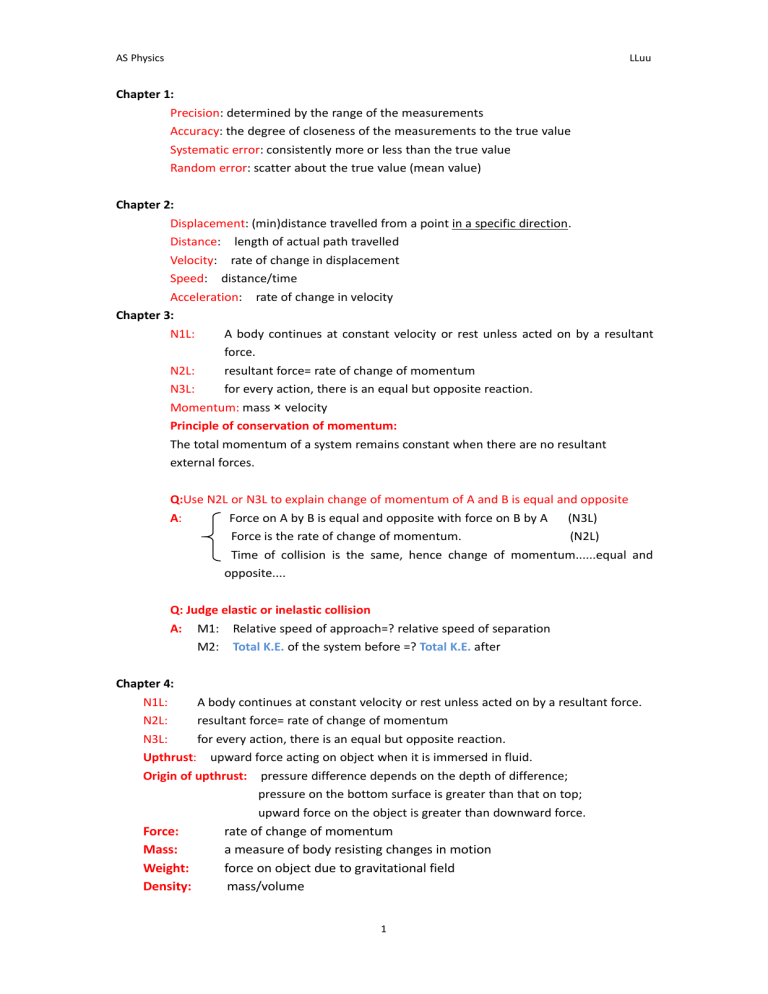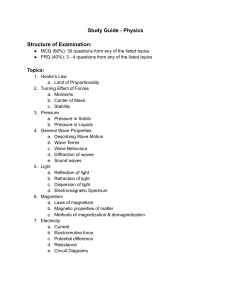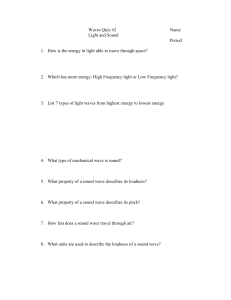
AS Physics LLuu Chapter 1: Precision: determined by the range of the measurements Accuracy: the degree of closeness of the measurements to the true value Systematic error: consistently more or less than the true value Random error: scatter about the true value (mean value) Chapter 2: Displacement: (min)distance travelled from a point in a specific direction. Distance: length of actual path travelled Velocity: rate of change in displacement Speed: distance/time Acceleration: rate of change in velocity Chapter 3: N1L: A body continues at constant velocity or rest unless acted on by a resultant force. N2L: resultant force= rate of change of momentum N3L: for every action, there is an equal but opposite reaction. Momentum: mass × velocity Principle of conservation of momentum: The total momentum of a system remains constant when there are no resultant external forces. Q:Use N2L or N3L to explain change of momentum of A and B is equal and opposite A: Force on A by B is equal and opposite with force on B by A (N3L) Force is the rate of change of momentum. (N2L) Time of collision is the same, hence change of momentum......equal and opposite.... Q: Judge elastic or inelastic collision A: M1: Relative speed of approach=? relative speed of separation M2: Total K.E. of the system before =? Total K.E. after Chapter 4: N1L: A body continues at constant velocity or rest unless acted on by a resultant force. N2L: resultant force= rate of change of momentum N3L: for every action, there is an equal but opposite reaction. Upthrust: upward force acting on object when it is immersed in fluid. Origin of upthrust: pressure difference depends on the depth of difference; pressure on the bottom surface is greater than that on top; upward force on the object is greater than downward force. Force: Mass: Weight: Density: rate of change of momentum a measure of body resisting changes in motion force on object due to gravitational field mass/volume 1 AS Physics LLuu Centre of weight: point at which the whole weight maybe considered to act Conditions for equilibrium: resultant force is zero, and resultant moment is zero. Torque/moment: product of force and perpendicular distance from a pivot Couple: a pair of forces, which are equal in magnitude but opposite in directions Torque of couple: one force × perpendicular distance between the two forces Principle of moments: when the object is in equilibrium, the sum of clockwise moments about a pivot is equal to the sum of anticlockwise moments Chapter 5: Work done: Product of force and distance moved in the direction of the force. Kinetic energy: energy of object due to its motion Gravitational energy: stored energy in object due to height in gravitational field Elastic energy: stored energy in object due to deformation Power: work done/ time taken Principle of conservation of energy: the total energy in an isolated system is constant Efficiency: useful output energy (power)/total input energy (power) Chapter 6: Hooke’s law: force is proportional to extension within limit of proportionality. Elastic potential energy:stored energy in object due to its deformation/extension or compression Strain energy: ability to do work as a result of a change of shape of object Stress: force/cross-sectional area Strain: extension/original length Young modulus: stress/strain Elastic deformation:Remove the load and the spring returns to its original length Plastic deformation:Remove the load and the spring can not return to its original length Elastic limit: point beyond which the spring does not return to its original length when the load is removed /the force beyond which the spring becomes permanently deformed Chapter 7: Transverse wave: vibration of particles perpendicular to direction of energy transfer Longitudinal wave: vibration of particles parallel to /along the direction of energy transfer Progressive wave: transfer of energy as a result of oscillations/vibrations Displacement of wave: distance of a point on wave from rest position Amplitude: maximum displacement from rest position Wavelength: distance between adjacent wavefronts Frequency: number of oscillations per unit time of a point on the wave Period: time taken for one complete oscillation Rarefaction: region of low pressure in longitudinal wave Compression: region of high pressure in longitudinal wave Wavefront: a surface in which all the particles on it vibrate in phase 2 AS Physics LLuu Diffraction: when a wave is incident on an edge(obstacle), wave spreads out Phase difference: a fraction of cycle between two oscillating particles Wave speed: speed at which energy is transferred/ speed of wavefront Polarised wave: vibrations are in one direction and normal to direction of wave energy transfer Doppler effect: difference in the observed/apparent frequency when the source is moving relative to the observer. Chapter 8: ①Stationary wave: Principle of superposition: When two (or more) waves meet (B1), resultant displacement (B1)is the sum of individual displacements (B1). Interference: same as principle of superposition Difference between stationary wave and progressive: Stationary wave: no energy transfer/ nodes or antinodes/ adjacent particles in one loop are in phase/ amplitude varies from 0 at the nodes to maximum at the antinodes Progressive wave : transfer energy/ no nodes or antinodes/ adjcanent particles in a loop are out of phase/all particles have same amplitude Conditions for forming stationary wave: 1. Two waves in opposite directions meet; (B1) 2. Waves are same type, same frequency (wavelength,speed), same amplitude (B1) e.g. (incident wave and its reflected wave) How to form stationary wave: 1. Incident wave reflected at fixed end; (B1) 2. Incident wave and reflected wave superpose/interfere. (B1) 3. They are same frequency, same type, same wavelength......(B1) Node: (points where is) zero amplitude/displacement Anti-node: (points where is) maximum amplitude ②Interference: Coherence: constant phase difference How to produce two sources of coherent waves and observe interfering waves ※Two dippers are connected to the same vibrating source, (B1) lamp with viewing screen in opposite side of tank (B1) and use strobe to freeze the picture (B1) ※Two loudspeaker are connected to the same vibrating source; ※Microwaves transmitter transmits towards a double gap in metal barrier; ※A laser(monochromatic) light is incident on double slits on a thin plate; Constructive interference: path difference is a whole number of wavelength, n or phase difference is 0 Destructive interference: path difference is an odd number of half wavelength, n 12 or phase difference is 180°. Conditions for the two waves may interfere (maxima/minima): 1. Same type (both transverse or longitudinal) waves meet a point (B1) 3 AS Physics LLuu 2 Coherent (constant phase difference) (B1) 3. Same direction of plorisation, (B1) 4. Path difference is 0 , , 2 ,.... / path difference is How interference maximum/ (minimum) is formed? 3 , ,.... 2 2 The path difference between two coherent waves is n ,/ ( n 12 )or phase difference is 0,/ ( 180 n 360 ) 如果解释为什么在某点是 maximum/bright fringe? 三步! IMPORTANT!! 1. Waves meet/overlap at the point 2. Path difference is ____, and phase difference is ______. 3. B1 B1 So it’s _______/_________interference, intensity is maximum/minimum B1 注意:四种波干涉中,除了可见光描述可以用 fringe..., 其他只能用 maximum/minimum. 可见光干涉用 fringe, 光栅用 line ③Diffraction grating: Diffraction: When a wave passes through an edge (obstacle), wave spreads (out). Chapter 9-10: Define e.m.f of a source Energy transferred (from chemical energy to electrical energy) in driving unit charge around the complete circuit Define electrical potential difference energy transferred (electrical energy to other forms)per unit charge Disgusting e.m.f. of a source and p.d. across a resistor Both measure energy (work)/charge For e.m.f. transfer chemical energy to electrical energy For p.d. transfer electrical energy to thermal energy/other forms Define resistance of a resistor Potential difference/current Define internal resistance Resistance of the cell causing loss of voltage ( energy loss in cell) Current Charge flowing through per unit time/ rate of charge flow/ flow of charge carrier Define the ohm Volt/ampere Define the volt Joule/coulomb 4 AS Physics LLuu Kirchhoff’s first law: Sum of currents into junction=sum of currents out of junction Or sum of currents at a junction is zero. -------linking with conservation of charge Kirchhoff’s second law: Sum of e.m.f. (s) =sum of p.d. (s) around a loop. --------- linking with conservation of energy Why terminal potential difference is less than e.m.f. of the battery? ---Thermal energy is dissipated in internal resistance. Why the terminal potential difference is not constant? There is potential difference between internal resistance (B1) (Resistance changes as temperature changes, so current changes) As the current changes, the p.d. across internal resistance changes (B1) V=E-Ir, so terminal potential difference, V is not constant (B1) Chapter 11: ① Alpha-particle: helium nucleus or 2 protons and 2 neutrons Nuclear structure of atom Most alpha-particles pass straight without deflection or a little deflection -------------------Most of an atom is empty space Minority/ a few alpha particles deflect with a large angle (angle >10) ------------------ Nucleus is positively-charged with large mass (small volume) Extremely small amount of alpha-particles deflected back (angle > 90) ------------------- the nucleus is charged B1 Most mass of the atom is in the nucleus B1 ② " " decay: electron+antineutrino / " " decay: positron +neutrino Q: Why the particles are emitted with a range of kinetic energies? A: Antineutrino is emitted and energy can be shared with antineutrino. Mass deflect Q: A: mass changes to “seen” as form of energy. -decay energy releasing ( E mc 2 ) K.E. of nucleus K.E. of nucleus radiation 5 B1 AS Physics Q: LLuu -decay energy releasing ( E mc 2 ) A: K.E. of nucleus K.E. of particles Neutrino or antineutrino is produced radiation Quantities conserved in decay: Proton number Nucleon number Momentum Mass-energy ③ Four fundamental force/interaction: Gravitational force Electromagnetic force Strong nuclear force 通过引力子?交换作用 通过光子交换作用 ( 0.5 l 4 fm attraction) Weak nuclear force ( decay ) Fundamental particles: lepton, Hadron Particles 通过胶子/介子交换作用 0 通过玻色子 ( W , Z )交换作用 quark......gauge bosons (规范玻色子不考) Proton: uud Baryon: made up of three quarks ....... Neutron: udd Meson: made up of two quarks (a quark + an other anti-quark) 强子基本都是由夸克和反夸克组成的! Lepton Electron, positron............ Neutrino, antineutrino............. e ve v ....... v Hadron: 参与强相互作用,也可参与弱相互作用,带电的还可参与电磁相互作用 Lepton: 不参与强相互作用,参与弱相互作用,带电的还可参与电磁相互作用 6 AS Physics LLuu Up Down Strange Charm Bottom top 2 e 3 1 e 3 1 e 3 2 e 3 1 e 3 2 e 3 Q: Determine, in terms of the elementary charge, e, the charge of proton. A: proton is consist of two up quark and one down quark (uud) B1 Up quark is +2/3 e and down quark is -1/3 e B1 Charge= 2 ×+2/3 e- 1/3 e = +e B1 Q: during decay, describe the change to the quark composition A: up down down changes to up up down B1 7







